
Jahnava Nitai Das
-
Content Count
4,026 -
Joined
-
Last visited
-
Days Won
2
Posts posted by Jahnava Nitai Das
-
-
Prabhupada: Now, in the absence of Krishna, they would be puffed up. Therefore they would be turned again into demons: "Oh, I belong to Krishna's family." Just like in our country, Nityananda-vamsa: "I belong to the Nityananda Prabhu," exploiting people.
-
Prabhupada: In Bengal... Just like they say nityananda-vamsa. Coming from Nityananda. So Nityananda had one son, Virabhadra. But Virabhadra did not marry. So there is no dynasty by semina. By nityananda-vamsa means by disciplic succession. So sometimes extra advantage was taken as nityananda-vamsa.
-
Prabhupad Premgopal Goswami is the 14th great-grandchild of Lord Nityananda and the direct current link to Lord Caitanya MahaprabhuThe followers of Bhaktisiddhanta do not accept that there are descendants of Nityananda prabhu existing today. It is a made up claim. As such, their sole claim to authority (their birth line) is a lie. Without their claim to fame, they have no authority to represent Sri Caitanya, as they themselves state their authority comes from their supposed birth in the family of Nityananda.
Furthermore, they are not "the" direct link to Caitanya Mahaprabhu today, as they have advertised. That indicates that they accept no others as direct links to Caitanya Mahaprabhu. They are offenders to the lotus feet of the real direct links to Caitanya Mahaprabhu.
Those who have no respect for Bhaktisiddhanta Saraswati Thakur have no business being invited into his Mathas and temples. These followers of Puri Maharaja are probably deviants with no authorization from Puri Maharaja, though I cannot say for sure. It seems to be the speculation of his disciples in Vienna.
-
In case anyone has not been to Ayodhya or had not seen the Babri Masjid, this is what it looked like:

As you can see, it was an abandoned mosque in the middle of nowhere, overgrown with trees. If you go today to Ayodhya the mosque is gone, but you can see the location it was in. It is just huge empty fields, for perhaps 100 acres.
This will be remembered as one of the stupidest and selfish actions to have been done by Indian politicians.
Here is an interesting statement from 1918 about a well at the Babri Masjid that both Hindus and Muslims considered to have miraculous healing powers:
The earliest mention of the Babri water well was in a two line reference to the Mosque in the Gazette of Faizabad District 1918 which says “There are no significant historical buildings here, except for various Buddhist shrines, the Babri Mosque is an ancient structure with a well which both the Hindus and Mussalmans claim has Miraculous properties.”So at some point everyone got along and forgot about the past invasions and fighting. But politicians chose to revive the hatred in order to win the elections, and that is how the BJP finally came to power.
-
Good points. On the other hand, fundamentalist Hindus destroyed a mosque in Ayodhya just a few years ago, didn't they?And as a result of the Ayodhya mosque being destroyed, tens of thousands of people were murdered in a few days throughout India. For example in Bhadrak, where our ashram is, at least a thousand people were murdered in two or three days after the mosque was destroyed.
Bhadrak is a very small village, located thousands of miles from Ayodhya (where the mosque was destroyed). But because some intollerant Hindus destroyed a mosque (which was abandoned and unused anyway), we had a thousand innocent people murdered here. Violent gangs on both sides targeted the weak and innocent and killed who ever they could get their hands on, until the military arrived with several thousand soldiers. But by then everything was already finished. The victims were mostly Hindus who lived in Muslim neighbhorhoods and Muslims who lived in Hindu neighborhoods. No one was brave enough to attack the other people's neighborhoods, instead they acted like cowards targeting helpless individuals.
The main bazaar (Purna Bazaar), which was owned mostly by Hindu Marwadis took the brunt of it, because the market was located in the Muslim neighborhood. The gangs purposely targeted all these shops, burnt them to the ground and killed the owners inside, so that they could loot the valuables. Even today, 15 years later, there are several complexes, 3 or 4 stories tall, completely burnt out that no one dares to step in or try to repair. Anytime you drive by that market you are reminded of the rioting. All the walls are black with soot from the fires that were set.
Every single year on Ram Navami (15 years so far) the Indian military sends 3,000 soldiers to this tiny village of Bhadrak, and they spend two days marching through the streets in a show of force to make sure no one gets any ideas.
So that is the result of religious hatred which is present even in some Vaishnava's. It takes only the smallest spark to cause a huge fire, maybe even thousands of miles away. As devotees of Lord Krishna we need to respect everyone's freedom of conscience and right to worship, and not interfere in their chosen religion.
-
This seems to be the real issue - are Muslims in India so much overstrained of not being able to manage the feeding of their own children in a highly fertile agricultural nation with 5 harvests per year? The answer is, yes, Muslims urgently are in great need of being supported by the aksaya-patra feeding the poor program:You seem to think ISKCON is giving them something that is not their right. You are completely mistaken on what this program is. It is a government funded program to provide food in all schools throughout India. Akshaya Patra is not giving the food, the government of India is providing the food. Akshaya Patra is a hired cook, hired by the government of India to prepare the meals and deliver them to the schools. The ingedients are given by the government of India. This program exists throughout India and Akshaya Patra is just one organization involved in it. Anyone can apply to the government for the cooking contract. The government will judge each application based on the cooking facilities you have, the cleanliness you maintain, your past track record, etc., and award the contracts based on that.
In summary the food being given in the schools is a promise from the government of India to every single child in India. These children, as citizens of India have a natural born right to receive this free meal in their school as long as the government of India continues to maintain this program. ISKCON's role in it is only as a hired cook to prepare the food and deliver it. If ISKCON backs out, there will be a thousand other organizations lining up to get the same contract from the government of India of cooking and preparing the meals.
As such, the Muslims don't want Hindu cooks coming, cooking the food and offering it to their Hindu gods before delivering it in their Islamic schools.
Your perception that it is "Muslims in India who are unable to feed their own children" is just a reflection of your hatred of Muslims. Poverty in India is universal. It does not discriminate based on which religion you are born into. There are more Hindus starving in India than Muslims, around 10 for every 1 Muslim.
Religious hatred, as displayed in your own thinking, is exactly what these Muslims don't want. They do not want ignorant and intolerant Hindus trying to secretly convert them by feeding them food offered to Hindu gods, while telling everyone how ignorant and poor the Muslims are. You can keep such "compassion" for your own people, no one wants it.
-
Even the muslims who destroyed so many Krishna Temples?I don't know of any living Muslim who has destroyed temples of Lord Krishna in India. They all died hundreds of years ago. It is ignorance to hold present people responsible for actions performed hundreds of years ago by their forefathers. That would make most of white America responsible for slavery and plenty of other crimes. If the Germans can be forgiven for their crimes committed just 60 years ago, why can't you forgive Muslims for crimes committed hundreds or even a thousand years ago. I think subconsciously it has something to do with religious intolerance. Since the germans followed Christianity we can forgive them easily, but with Islam we have a stronger internal dislike.
Didn't Prabhupada say 'Let there be one God Krishna, one scripture Bhagavad Gita. And one religion, Sanatam Dharma or Krishna Consciousness.Yes, let everyone voluntarily take to Krishna consciousness. It has nothing to do with violating people's freedom to choose their own religion.
-
Ganesh is Gam. But it is possible your mantra contains multiple seed letters and both may be present. If it is only a single seed letter it is likely Gam.
-
Hanuman is an eternal associate of the Lord in Vaikuntha, so he is not at all bound by limitations such as material strength. For the sake of the Lord's lila he acts as though he is a mortal, and sometimes the Lord's yogamaya covers him so that he will even think that he is mortal. This increases his enjoyment and excitement when participating in the Lord's lila.
But in reality he is equally beyond the limit of a material boon granted to Vali, just as Lord Rama was. Vali was given a necklace by Indra, and that ganted him his material strength.
Another point I have heard, but have not taken the time to look up and confirm is that in the Ramayana it is only said that Vali gains half the strength of the opponent. It never says that the opponent is weakened to half his strength. If that is the case, then it would be possible for Vali to gain the strength of an opponent and still be weaker than the opponent.
As Vali would have His strength + 1/2 opponents strength
where as opponent would have 2/2 opponents strength.
If Vali's own strength was less than 1/2 of the opponents strength, then he would still be weaker than the opponent even after his boon is fulfilled.
As far as the Lord is concerned, it is impossible to copy any of his strength. Thus no such boon could have been maintained.
-
it is not me, dude. Read the discussion between Rama and Vali when Vali is dying. Not a color book version of the Ramayana from iskcon you may be accustomed to, but a more authentic one that has been around for a few hunded years.If you read Valmiki Ramayana, you would be aware that Valmiki provides two explanations for why Rama has acted this way. And if you read Kamba Ramayana, you will find six explanations are given. So it really is more or less you and those who wish to find fault with the Lord.
-
The answer usually given is that if Vali saw anybody, then Vali would get half strength of that person. But is that really the reason? Is it true that if Vali had seen Rama, then Rama would have lost half of His strength to Vali and thus Vali would have won?If Lord Rama had been seen by Vali, nothing would have happened and the benediction Vali had received would have proven false. Lord Rama never wants his devotees to be insulted for not fulfilling their promises of benediction. Rather than let the devotees have a bad name and be insulted, He allows His own name to be criticized by people like Shvu so that His devotee's name and reputation remains always protected.
A similar case occurs with Lord Narasimha when He kills Hiranyakashipu. He goes to so many lengths to uphold the benedicition of Brahma even though He could have killed Hiranyakashipu like a small ant.
-
When everyone was small I'm sure you saw some other kid in a swimming pool with a big inflatable bed or tube and really wished you had it to play with. All kids dream of having a nice inflatable bed to float on in the waters. Everything originates in Krishna, even the desire to float on a bed in the swimming pool.
-
In sanskrit the R without any vowel after it, but with another consonant following it, is written as a small hook above the bar that joins all the letters, similar to how the vowels are written.
For 'R' that comes after a consonant and before a vowel, like in "pra" it is added as a diagnal line within the letter 'pa'.
-
It has always mesmerized me that the jewels on the heads of the Naga are the Suns that illuminate the subterranean realm.I have heard stories of people's grandfathers who have seen "illuminated" nagas in villages in Orissa in the rice fields late at night. All of these have occured more than 40 or 50 years ago. Of course they are unverifiable and we have to just hear them as interesting tales. Back then there was no electricity in these places, and even today most villages have very little electricty, and the rice fields of course still have no electricty. They describe seeing very, very bright lights illuminating the remote rice fields.
A more verifiable topic is people with snake mantras that remove poison from people with snake bites. These are still very common in Orissa and Bengal, and most people come to such people after being bitten rather than go to doctors. Actually most places there are no hospitals close enough and anti-venom is not kept accessible. Even with anti-venom there is a high mortality rate for cobra bites. And another problem is trying to identify which snake has bitten you, as the bite usually occurs during the early morning or late night when people go outside to pass in the rice fields. So taking all of that together, people have developed more faith in snake mantras. Unfortunateoy there are many fake people involved in this, but still there are many genuine people.
Even in Mayapur the devotees for many, many years would go to se Mukul Baba, a Muslim who would remove snake poison by mantra. Even in the time of Srila Prabhupada this was going on and Srila Prabhupada has mentioned it in some conversations. He has since passed away and his son carries on the practice, but I hear he is not as good as his father. When they chant the mantra, all the poison in the body comes down to the bite location and that particular area becomes completely dark blue or black. Then they are able to remove it from that place. Similar practices are very common in almost every village in Orissa and Bengal.
-
Poison givers are one of the invaders that are authorized by Vedic injunction to be killed.The actual Vedic injunction is that one who has administered poison may be killed. Of course this is an injunction in regards to humans, which is obvious from the other 5 injunctions that go with it. (one who steals your wife, one who sets fire to your house, one who attacks with deadly weapons, one who plunders riches...) These all refer to humans voluntarily hurting other humans, and thus they are fit to be punished.
Regardless, the injunction refers to one who has administered poison, not to one who has the potential to administer poison. If that was the case, for the other injunctions you would have to kill anyone who simply possessed a deadly weapon, regardless of whether they planned to use it against anyone or not.
-
There are two classification of snake like beings, the sarpa and the naga. Sarpa refers to snakes and nagas refer to celestial demigods who also possess snake like bodies.
Krishna speaks seperately of each in the Gita (10.29, 10.28):
anantas casmi naganam
varuno yadasam aham
pitrnam aryama casmi
yamah samyamatam aham
"Of the celestial Naga snakes I am Ananta; of the aquatic deities I am Varuna. Of departed ancestors I am Aryama, and among the dispensers of law I am Yama, lord of death."
ayudhanam aham vajram
dhenunam asmi kamadhuk
prajanas casmi kandarpah
sarpanam asmi vasukih
"Of weapons I am the thunderbolt; among cows I am the surabhi, givers of abundant milk. Of procreators I am Kandarpa, the god of love, and of serpents I am Vasuki, the chief."
Among the Nagas Lord Krishna is represented by Ananta, and among the snakes (sarpas) He is represented by Vasuki.
Killing of Nagas is always prohibited in the scriptures, and in Vedic astrology "Naga Dosha" is considered one of the geat sinful afflictions in a chart. Naga Dosha is the result of having killed a Naga in a previous life.
In one conversation Srila Prabhupada speaks of his own experience with a snake:
Prabhupada: There was a snake. He was living under my bed. So you know katiya (?) The rope, katiya? So I saw something is hanging like snake tail. So I called my servant, "There must be some snake. Some tail is hanging." So the servant, they called all their friends. They came with stick, about a dozen. And as soon as the mattress was taken, there was snake. So I told them, "Don't kill it. No, no.Nei saheb, yei nei hatya." (?) Ah, immediately killed.
"Do not kill it", that is the compassion of a saintly person. In India there are countless scorpions and snakes. You can either spend your time killing them out of envy, or you can learn to see Krishna in them like the Gita reminds us. Even though the Bhagavatam says modeta sadhur api vriscika-sarpa-hatya ("...even saintly persons take pleasure in the killing of a scorpion or a snake..."), the same Bhagavatam says:
mrigoshtra-khara-markakhu-
sarisrip khaga-makshikah
atmanah putravat pasyet
tair esham antaram kiyat
"One should treat animals such as deer, camels, asses, monkeys, mice, snakes, birds and flies exactly like one's own son. How little difference there actually is between children and these innocent animals."
Srila Prabhupada has also stated on many occasions the same point:
Prabhupada: And in the Vedic conception of grihastha, householder, it is recommended there that a householder shall see that even a lizard living in the room or even a snake living in that house should not starve.
Prabhupada: Even there is a snake in the house, the householder is to see whether the snake has got his food.
Prabhupada: Even there is a snake—nobody likes snake—but a Vedic householder has to call the snake and give him food. He also may not remain hungry.
Prabhupada: Even a snake is there, he should not also starve. He must have food.
Prabhupada: Srimad-Bhagavatam instructs that even if there is a snake or lizard in the house, it is the duty of the householder to see that they are also eating, not starving.
Prabhupada: According to our Vaisnava philosophy even a snake or lizard is in the house shall not go without eating, what to speak of other living entities. The communists have an idea for feeding human society, but our idea is expanding. We want to see even a snake not fasting.
So over all:
1) We need to first understand the distinction between sarpa (snake) and naga. Nagas are never to be killed according to scripture. Killing a Naga brings great misfortune in this life and the next.
2) Both sarpas and nagas should remined us of Lord Krishna as mentioned in Gita.
3) Even the snakes should be shown compassion and treated as our own children, as mentioned in the Srimad Bhagavatam
4) From the personal example of Srila Prabhupada we see how he wanted compassion to be shown to a snake living under his bed.
I have heard a similar story of Gour Govinda Maharaja having three giant scorpions living under his bed (the size of your hand). This was 30 years ago when he was mostly alone in his hut. One devotee was cleaning his room and came across the scorpions. He panicked and went to Maharaj saying that he was cleaning the room and he came across these monster scorpions and he needed to get them out. Gour Govinda Maharaja replied, "Oh yeah, them. They have also been living in my room. They don't bother me. You can let them be there."
Maharaja could have quoted the verse from the Bhagavatam about how delighted saintly people become when they kill scorpions and snakes. But the reality is saintly people don't become delighted when scorpions and snakes are killed. It is a poetic verse meant to show how the world looks on envious demons like Hiranyakashipu. It is not a license for vaishnavas to go scorpion hunting and snake hunting.
I have seen cases where devotees enthusiastically have killed snakes, and I didn't see anything gained out of it. Rather I could feel it was an act of anger and passion due to a low level of consciousness. You have to first see Krishna in their hearts before you have any right to act in any way. If you can't see Krishna in the heart of an animal or human, then you shouldn't be interacting with them at all untill your consciousness is raised.
-
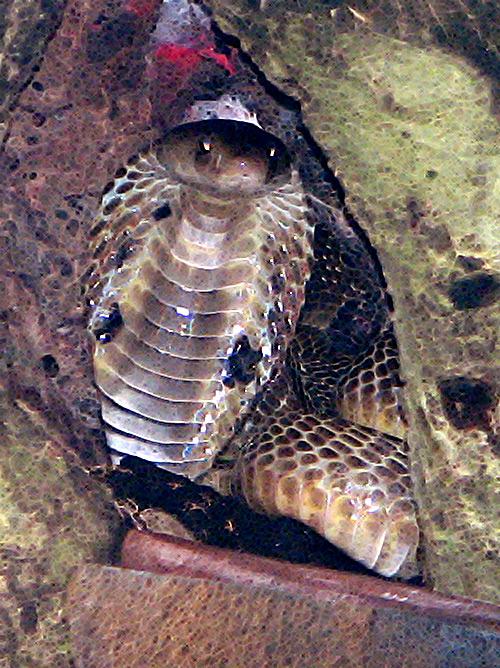
Dear friends and devotees,
Jaya Sita Rama. Please accept my humble pranams.
Quite unexpectedly, on the auspicious occassion of Naga Panchami (the traditional day for worshipping snakes and Nagas), a divine Naga appeared at our Sri Jagannatha temple in Bhadrak, to bless devotees.
The cobra was first seen early morning, around 5 a.m., inside the hollow of a Kadamba tree next to Sri Jagannatha's altar. At first the devotees could not identify that it was a Naga and thought to chase it away, as there are several other types of poisonous snakes in this area. There were many attempts to tap it softly with a long stick so that it would leave and not endanger anyone, but it did not react at all. Even after trying to chase the snake away for more than half an hour, repeatedly tapping it with a long pole, it remained silently coiled in the tree, completely ignoring attempts to get it to leave.
After many attempts, a 90 year old traditional snake expert came and confirmed that the snake was a Naga and would not harm anyone. He approached the tree and bowed his head against the opening in the tree, just inches away from the cobra. The cobra was not at all disturbed by his presence and did not react even though his head was just a few inches from the snake.
He informed us that today was Naga Panchami, and that this snake must not be an ordinary snake. Frank incense was then brought to offer to the snake to see if it was truly a Naga. As soon as the large pot of frank incense (sambrani/jhuna) was offered to the snake, it immediately stood up and opened it's hood wide, making a large hissing sound. After a few minutes it again lowered its hood and sat silently inside the Kadamba tree, sitting peacefully throughout the entire day and night.
As word spread, more than 1,000 villagers arrived throughout the day and night, bringing offerings of milk and deepams, to receive the blessings of the Naga. In Orissa, Nagas are considered as signs of Lord Shiva (Akandalamani). With the recent installation of Sri Vimala Devi (Durga), the Naga is seen by the villagers as the divine presence of her husband Lord Shiva.
By nightfall, when the temple was closed, the Naga was still sitting inside the hollow of the Kadamba tree. The next morning when priests went to awaken the deities of Lord Jagannatha, the Naga was no longer present. He came only for the occassion of Naga Panchami, and sat silently the entire day and night to give darshan to all of the visiting devotees.
In Lord Jagannatha's temple in Puri, Nagas are said to guard the deity's treasure chamber. Below the temple there are secret rooms that no one is allowed to enter, and these are used to store the Golden Dress (Suna Vesh) as well as many other jewels that belong to the deity. These chambers are filled with divine Nagas who guard the Lord's treasury. Only one person will be allowed to enter this treasury, and he can do so only after fasting, performing specific austerities, and offering prayers. Once the nagas have been satisfied, the pujari is then allowed safe passage to collect Lord Jagannatha's jewels and dresses. Thus the celestial Nagas have been tied to the service of Lord Jagannatha for thousands of years.
Yours in service,
Jahnava Nitai Das,
Bhaktivedanta Ashram &
Bhaktivedanta International Charities
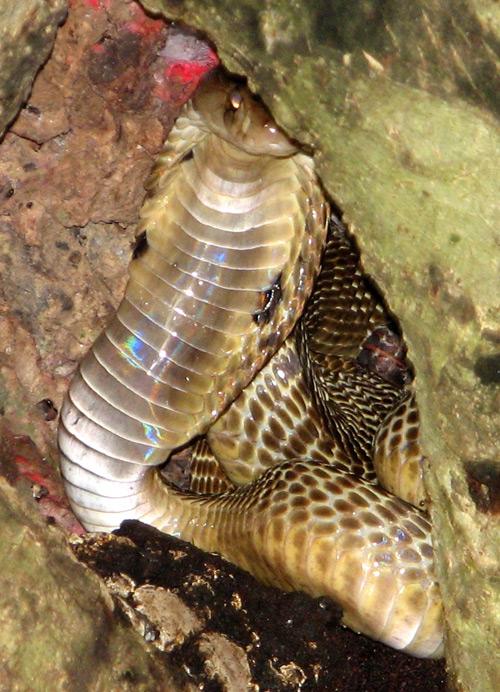
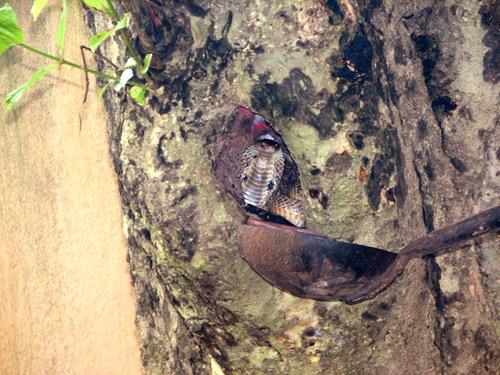
[ Devotees offering milk to the divine Naga on Naga Panchami ]
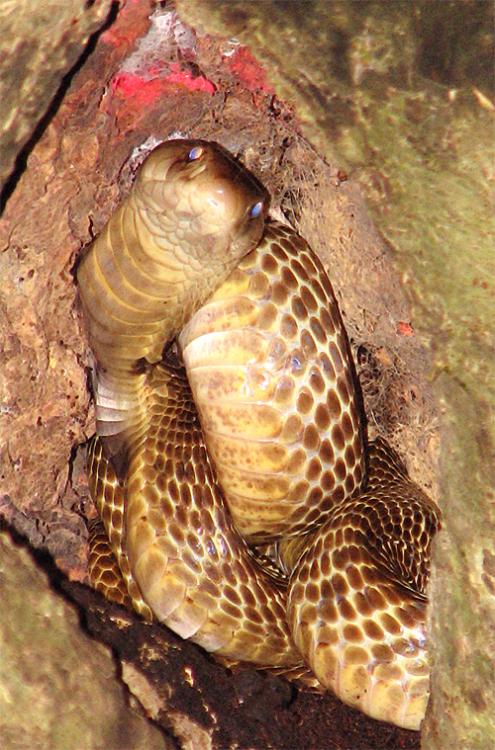
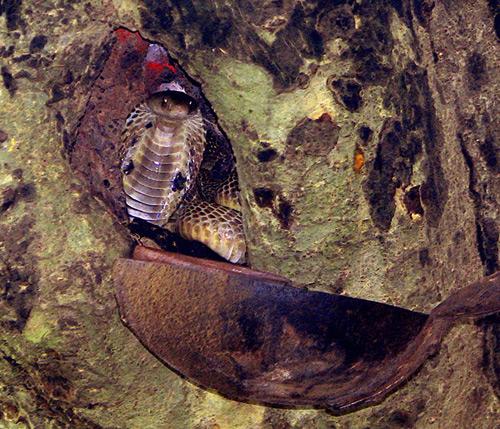
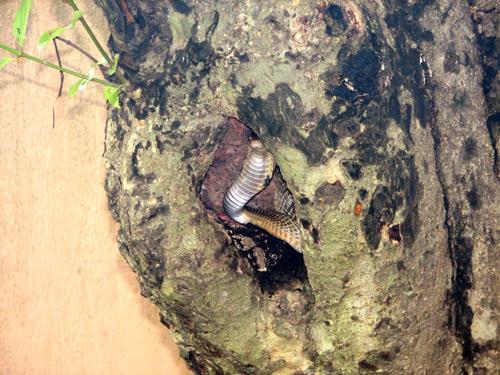
-
There was a book compiled by one of Bhaktisiddhanta Saraswati's disciples listing all of the physical remnants from Lord Caitanya's pastimes.
Several other items are even mentioned in Sri Caitanya's biographies themselves, and they can still be located today in the same locations mentioned, being worshipped by descendants.
This particular blanket is not mentioned in Caitanya's biographies, but is mentioned in the book by Bhaktisiddhanta's disciple, and it is universally accepted as authentic amongst Gaudiya Vaishnavas in India. Beyond that there is no chemical test to ascertain if it was touched by God or not.
As a side note, the blanket is now down to a piece of just 7 or 8 inches square. I am sure it started as a full blanket and different saints were given pieces of it over hundreds of years gradually making it into a tiny portion of the original blanket.
-
From http://www.bvashram.org/articles/137/1/
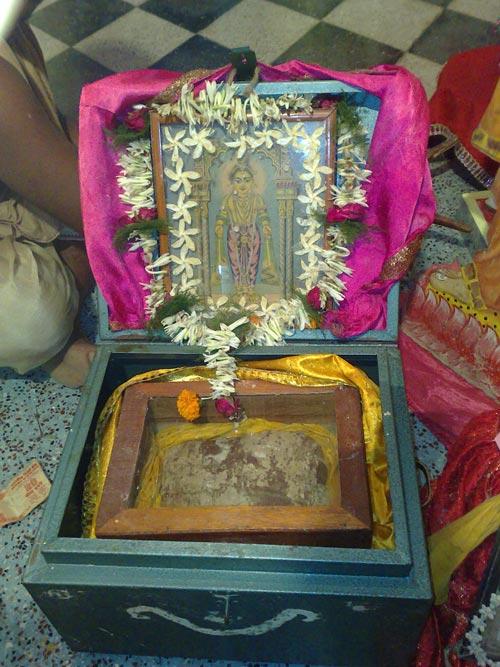
Dear friends and devotees,
Jaya Sita Rama. Please accept my humble pranams.
500 years ago, while walking from Navadvipa to Puri, Sri Caitanya Mahaprabhu spent the night in Bhadrak on the banks of the sacred Salandi river. He stayed at an ancient temple of Sri Sri Radha Madana Mohana (located in Santhiya village). Before departing for Puri, He blessed the temple pujari by giving him His personal blanket. This blanket has been worshipped for the last 500 years by the descendants of the original pujari.
The blanket is kept hidden in the temple throughout the year, but on one day each year (the anniversary of Sri Caitanya Mahaprabhu's visit to Bhadrak) the blanket is displayed to the public and a large festival is held. This year we were able to take a photograph of this sacred relic, so now everyone can have darshan of Lord Caitanya's personal blanket.
The blanket is brownish-red in color, and it is covered in sandalwood paste from hundreds of years of worship. The blanket is filled with white cotton, which is visible through some holes in the blankets cover.
If anyone would like to have direct darshan of this blanket, they should plan to visit Bhadrak just after the Ratha Yatra festival in Puri. Bhadrak was also the home of Srila Bhaktivinoda Thakur, a great saint in the line of Caitanya Mahaprabhu, so you can visit the school where he taught and served as headmaster for several years. Devotees can also take the opportunity to see the sacred wooden shoes of Sri Madhavendra Puri (Sri Caitanya's param-guru) located at Remuna, around 45 km from Bhadrak. Sri Madhavendra Puri's samadhi is located there, as well as the samadhi of Sri Rasikananda.
Yours in service,
Jahnava Nitai Das,
Bhaktivedanta Ashram &
Bhaktivedanta International Charities
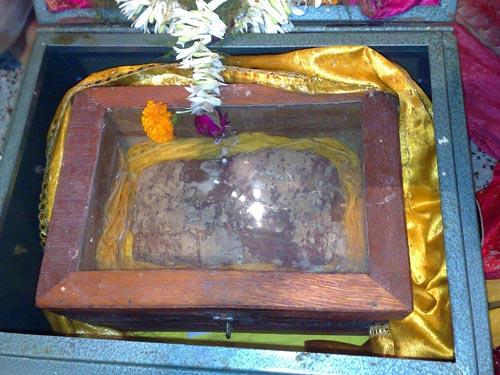
-
Feeding food that has been offered to Hindu gods to Muslims would be a good way to get yourself killed if in fact such an offense incites the anger of Islamic fanatics.This is another reason to avoid it. Already ISKCON temples have been targeted by Muslim terrorists. Doing something that is obviously extremely offensive to Muslims is just inviting them to target you.
Take your own risks if you want, but don't take risks that will endanger other devotees.
-
The real issue is the fundumental right to freedom of religion. Unfortunately some devotees feel they have the ultimate answer and therefore others should not be given the freedom to choose their own religion.
In ancient times the same mindset existed, but it was the Muslims who forced the Hindus to follow their "true religion". I'm sure you would consider that a great injustice. But at the same time you may be happy if the reverse is done - all Muslims being forced to follow Hinduism.
It is because of secular governments that you and I have the right to follow the religion of our choice. That same right you now want to take away from the Muslims simply because you think you have the right religion.
It has nothing to do with offense, sin, aparadha or any other of your religious catchphrases. It has to do with honesty and freedom of religion which should be granted to everyone.If you see this as the same offense, conditioned souls being forced to eat prasadam and Vaishnavas being forced to eat beef then it must be true.Do unto others as you would have them do unto you. I would not want to be forced to follow someone else's religion, so I won't force others to follow my religion.
-
When they heard that at school they get something to eat - a full meal, they started to reluctantly send their children to school. Now they found out that it is prasadam, offered to Lord Jagannath, and demand the bhog for themselves. But will they prepare food for their children, or rather take that bhog and sell it at the market?The schools are Islamic religious convents. All they are asking is that the secular government provide them the ingredients so that they can cook the food themselves, or arrange an NGO who will give them food not offered to a Hindu deity.
As Vaishnavas we also believe that we should not eat food cooked by non devotees. If our ISKCON gurukulas were forced to feed the children food cooked by Muslims and offered in a mosque, most would also object.
Whether or not these people will cook the food or sell it in the market is irelevant. The same question can be asked of any Hindu organization as well. This is not a question of corruption, but one of forcing religious beliefs onto another religious group. Corruption could exist anywhere in any religious organization.
The midday meal program is a government contract offered to thousands of non-government organizations throughout India, for providing free meals in India's schools. The contract has nothing to do with any religion or religious organization. It is not that ISKCON is giving them something free and the schools should have no say in what they get. The government is providing free meals in all schools throughout India, and they are hiring other organizations to carry out this work. In this case ISKCON is an organization hired by the government. The government is not hiring them to provide religious prasadam, but just food. Since the majority of India's population is Hindu, most people will not object that ISKCON is giving religious prasadam in the schools. But when you come to all-Muslim schools or all Christian schools we have to be careful not to hurt their religious sentiments.
If a muslim organization had received the contract to provide our ISKCON gurukulas with free meals, and they decided to secretly include beef in the meals for our "spiritual welfare" we would all be extremely angry. This is the same thing. You don't see it as wrong simply because it is in favor of your own religion. But if it was the other way around, you would be extremely angry.
Consider, these people are poor beyond our perceptivity. Still, approximately 25 million primary school-age children are not in school but kept illiterate by their Muslim parents. For those enrolled, 40 percent drop out before reaching Class V. Isnt this ignorance on several levels?Again this is an ignorant statement. Poverty in India has nothing to do with what religion you follow. I can show you Hindu tribal communities in Orissa where 95% of the children don't attend school and are forced to work in rice fields by the age of 6 or 7. It has nothing to do with what religion they follow. What is the point in mentioning how many Muslim children are illiterate? There are 10 times as many Hindu children illiterate in India as well.
If the government tries to force Muslim schools to feed their students religious food offered to a Hindu deity you will only increase tension and hatred between Hindus and Muslims. Religious harmony doesn't come by offending other people's religious beliefs.
-
India is a secular country, not a Hindu country. All religions should be respected equally in a secular country. Offering food to God is an ancient Hindu custom performed by individuals worshipping in temples. In this case, we are speaking of a secular government providing free meals to Islamic schools. It has nothing to do with ancient Hindu customs. The Muslims clearly don't want food offered to a Hindu deity, and that is understandable. Just because my religion says it is good for them doesn't give me the right to force it on them. How would you feel if in Muslim countries all Hindus were forced to eat halal beef because the Muslims thought it was good for you?
When the governement provides free meals to the citizens of India, they do it as a secular service to feed children. It isn't an ancient religious custom they are trying to fulfill. Actually there is no ancient religious custom that involves the government cooking and feeding prasadam to millions of children in schools throughout the country. The ancient custom has always been to offer food to God in temples.
If immigrants can't tolerate traditional rituals practised in the host country, very simple, they should be sent back where they came from - their country of origin.This is an ignorant statement on several levels. First, most of the Muslims in India have always been Indian. When the Muslims invaded India, they converted native Hindus to their religion. So for most of todays Muslims, there is no place "where they came from". Their country of origin has always been India. The only difference is their forefathers were Hindus, and they are not.
Why your statement is ignorant is because you are identifying a country of origin with a particular religion. It is like saying that your "country of origin" is India just because you are a Vaishnava. But the reality is most of the Vaishnavas in the west are not from India and are not Indian. Their country of origin remains the country they were born in - it has nothing to do with the particular religion they choose to follow.
India has many religious traditions, and no one should be forced to follow the rituals of a religion he does not believe in. As a Vaishnava, you would not want to be forced to follow buddhist, jain, or zorastrian customs, would you? These are all ancient traditions of India. So just because your tradition of offering food to God is ancient does not justify forcing others to follow it as well.
-
The ghee is labeled as 100% pure and vegetarian. The only way to actually verify it would be through laboratory testing, which is not possible for most people.
There are actually two problems. One is illegal aldulteration by the companies. And the second is printing of fake brand name packaging and filling with adulterated ghee by unrelated sellers. So you may think you are buying a pakage of ghee from the cleanest and best company in India, but actually someone printed a fake package and filled it himself with who knows what.
I don't know of any solution to this for devotees to know whether they are purchasing authentic ghee or not. Based on the general corruption in India, I would estimate that a lot of the ghee is probably adulterated and better avoided.
14th Descendent of Lord Sri Sri Nityananda Mahaprabhu
in Spiritual Discussions
Posted · Report reply
How many times was Prabhupada busy looking through his camcorder while having his feet washed?